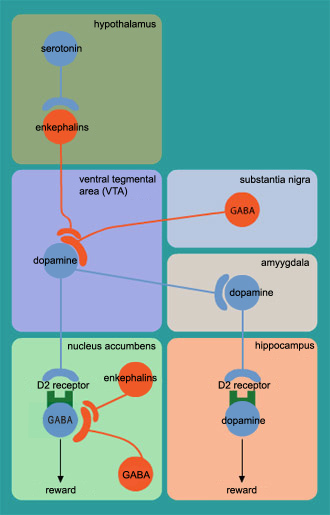PAIN
Pain is an unpleasant sensation often caused by intense or damaging stimuli; if intense and/or chronic, it can significantly interfere with a person's quality of life and general functioning. It is commonly known that psychological factors (such as sport excitement, war, hypnotic suggestion), behavior or natural substances (like opium) can significantly modulate pain's intensity or unpleasantness.
Several studies state that a stimulation of the Nucleus Accumbens has an analgesic effect:
The role of dopamine in the nucleus accumbens in analgesia
Dopamine D2-Like Receptor in the Nucleus Accumbens Is Involved in the Antinociceptive Effect of Nitrous Oxide
Stimulation of dopamine D2 receptors in the nucleus accumbens inhibits inflammatory pain
Therefore, we can think that every substance that can elevate the concentration of Dopamine in the neurons that projects from Ventral Tegmental Area to Nucleus Accumbens, can, in theory, have an analgesic effect

CHOCOLATE
The chocolate contains phenylethylamine(PEA), a psychomotor-stimulating molecule; it is an endogenous amine synthesized by decarboxylation of phenylalanine in dopaminergic neuron of nigrostriatal system.
Phenylethylamine functions as a neuromodulator or neurotransmitter in the mammalian central nervous system.

Phenethylamine is similar to amphetamine in its action and lead to the release of norepinephrine and dopamine. However when taken orally it is rapidly metabolized by MAO-A, MAO-B, aldehyde dehydrogenase, and dopamine-beta-hydroxylase. Phenylethylamine's half-life is 5–10 minutes.
In biochemical studies, systemic application of β-PEA stimulates the release of DA in the striatum and postsynaptic DA receptors. Because β-PEA alters several neurotransmitter systems and stimulates the release of DA, dopaminergic neurons could be involved in β-PEA-induced behaviors. An in vivo microdialysis study indicated that locally applied β-PEA directly produced a dose-dependent increase in extracellular DA release in the nucleus accumbens: Effects of β-Phenylethylamine on Dopaminergic Neurons of the Ventral Tegmental Area in the Rat: A Combined Electrophysiological and Microdialysis Study
Electrophysiological Effects of Trace Amines on Mesencephalic Dopaminergic Neurons demonstrated that β-PEA also inhibits the activity of Gabaergic (inhibitory) neurons in the substantia nigra using intracellular electrophysiological recording. Furthermore, β-PEA stimulates the neurons in an amphetamine like manner, causing a Ca2-independent carrier-mediated efflux of DA from the somatodendritic dopaminergic neurons in the VTA.
CONCLUSIONS:
It is possible identifying a biochemical connection between chocolate and a decrease in pain perception. Thus, further studies can be extremely useful to determinate if lower states of pain can be treated with a sweeter therapy.